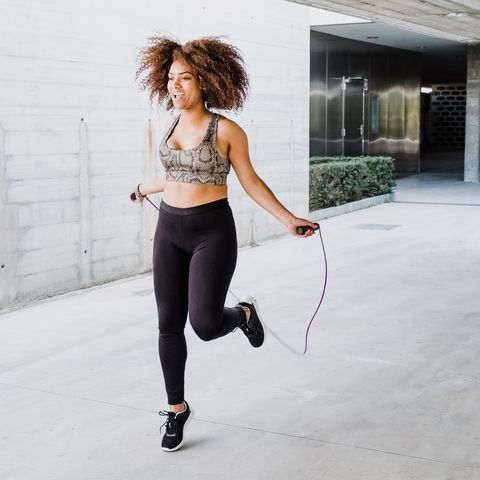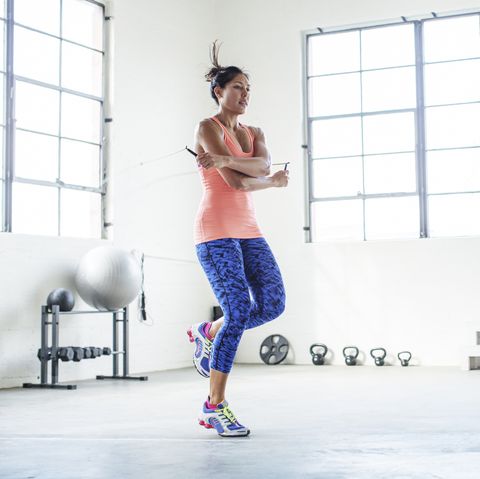There is much to love about jumping rope. Besides the nostalgia factor — flashback to the thwack, thwack, thwack of jumping rope outside with your neighborhood friends — this old-school piece of workout equipment is cheap, portable and provides a ton of fitness benefits. In addition to providing an effective cardio workout and strengthening your lower body, jumping rope also helps improve coordination, power and agility.
The beauty of jumping rope is that you don’t need much time or space to start. All you need is about 10 to 15 minutes to challenge yourself. Plus, you can even tuck your jump rope into your luggage for a quick workout while traveling. Here’s everything you need to know about the sport, including what muscles jumping rope works and its many health benefits.
Before starting any fitness regimen, always speak with your healthcare provider.
What is jumping rope good for?
Jumping rope is a high-impact, full-body exercise that requires swinging a rope over your head, then hopping over it as it passes your feet. The exercise demands constant movement that really gets your heart pumping.
Since jumping rope requires quickly bouncing on your toes while activating your fast-twitch muscles, it can be used to improve speed and agility. Some use it to increase explosive power in moves like a “double under,” or making two revolutions with the rope for each jump.
If you’re not ready to make jumping rope your main workout, you can also use the versatile exercise as a warm-up and/or cool down to compliment any fitness regimen. For example, 8 to 10 rounds of 30 seconds on and 30 seconds off is a great way to begin or end your workout.
What is proper jump rope form?
Form is everything when it comes to jumping rope. Without proper form, you’ll find it difficult to get into a rhythm and may put yourself at risk for injury.
- Hold the ends of a jump rope in each hand, with the rope’s loop resting on the ground behind your heels.
- Swing the rope forward over your head and in front of your body.
- Jump as it passes under your feet.
- Repeat. Start to create circular motion with your hands on the handle of the rope and find your rhythm.
Focus on keeping your chest lifted and core engaged throughout the workout. Your shoulders and elbows shouldn’t move much, and most of the movement will come from your wrists. While jumping, be sure to land on the balls of your feet and keep your knees slightly bent. Look straight ahead and jump as the rope crosses your line of sight. Remember that practice makes perfect, and just a little bit of practice each and every day can help you improve.
How to select a jump rope
An important step in mastering good form actually comes in finding the best jump rope for you. Emily Jacques, NASM-CPT and Rumble XPRO for Xponential+ offers this guidance:
- Measure the rope. Stand on the middle of the rope with one foot and and raise the ends up near your body. The handles should come to your armpits or shoulders. Try to purchase a rope that you can either cut to your size or one that comes according to height.
- Not too heavy. Jacques recommends starting with a light jump rope. Once you’re comfortable, you may want to test out various weighted jump ropes to elevate your workout even more.
- Adjust as needed. If the rope is getting caught on your shoes, try a longer one; if you feel like the rope is dragging on the floor, go shorter.
Benefits of jumping rope
1. Improves endurance
Jumping rope requires fitness, focus and good footwork. The exercise activates nearly every muscle in your body while spiking your heart rate more quickly than many other exercises. In fact, the Centers for Disease Control and Prevention (CDC) considers vigorous exercises like jumping rope to be about twice as efficient as moderate-intensity activities. To maximize your jump rope endurance, work up to sessions of 20 to 30 minutes.
2. Increases agility and coordination
Jumping rope requires focus and rhythm, which can significantly improve your agility. You’ll work on timing and need mental focus to help with coordination between your eyes, feet and hands too. Since jumping rope is a cyclic activity, it requires a steady rhythm, total body connection and synchronization.
3. Builds bone density
Bone density tends to decrease with age which can lead to conditions like osteoporosis and osteomalacia. Plus, your risk for bone fractures increases with age. Building bone density with high-impact exercise like jumping rope can reduce those risks — like muscle, bone is living tissue that responds to exercise by becoming stronger. In fact, a 2015 study of premenopausal women found that those who performed 10 or 20 jumps with 30 seconds rest between jumps, twice daily for 16 weeks saw an improvement in hip bone mineral density compared to the control groups. According to the Mayo Clinic, if you have osteoporosis, it’s best to speak to your doctor before starting exercises like jumping rope since it can be more harmful to weakened bones.
4. Provides an effective warmup
Embrace a 5 to 10 minute jump rope warmup to prime your muscles for what’s to come. In a study in the International Journal of Sports Physiology and Performance, researchers looked at the effect of a 5 minute jump rope warmup vs. a traditional warmup for 96 endurance runners. After 10 weeks, the researchers found the jump rope warmup was effective in improving 3 km time-trial performance.
5. Builds strength and muscle
Jump rope muscles worked are calves, quads, hamstrings and as well as your feet and ankle muscles. It also works your core, shoulder and biceps. Proper form requires total body engagement, but Jacques says that jumping rope is especially great to build wrist and calf strength, something that’s great for boxers. Holding the jump rope’s handle and propelling the rope around you (especially if the rope is weighted) is excellent for the wrists. You also have to stay light on your feet which targets your calves.
6. Improves balance
Jumping rope can be an effective way to improve balance, and research has shown that when you’re jumping rope you have to re-establish your balance in between each jump. If you’re looking to level up your balance, there are many jump rope drills that can help with this. For example, one legged jump rope, jumping side to side or high knees can improve your balance as well as your motor coordination.
7. Increases explosive power
We’re strengthening your entire body from head to toe! Jumping rope is a type of plyometric training which recruits your fast twitch muscles and helps increase explosive power, says researchers. Improving your explosive power with jumping rope can translate to improvements in your sport or sprint performance too.
8. Improves heart health
When your heart is pumping when jumping rope, your oxygen and blood is traveling faster and more efficiently to your muscles. When there is oxygen in your blood pumping through your entire body this can help lower cholesterol and improve your cardiovascular health. The increased blood flow from jumping rope is good for your heart health, blood pressure and cholesterol.
9. Can be meditative
Jumping rope can be a form of active meditation. When you find your rhythm and flow you can focus on holding the rhythm or simply embracing the sound of each jump rope revolution. Jacques says it’s nice to pick a song you love and try to jump to the beat, as this can help you keep the rhythm and pace too.
10. Easy to travel with and versatile
Your hotel or Airbnb doesn’t have a gym? Pack your jump rope! You can jump rope inside your room or outdoors. It’s one of the most versatile, portable and lightweight pieces of exercise equipment that works great for travel. Consider bringing your jump rope on your next trip.
Intermediate 10-Minute Jump Rope Workout
This ten-minute sequence created by Jacques challenges endurance and stamina. It also incorporates recoveries that will help you catch your breath between intervals. Once you’ve mastered jumping on both feet for these intervals, you can try alternating to single-leg jumping for each 30-second interval to shake things up and challenge your balance.
- Jump rope for 60 seconds.
- Rest for 30 seconds.
- Jump rope for 60 seconds.
- Rest for 30 seconds.
- Jump rope for 60 seconds.
- Rest for 60 seconds.
- Jump rope for 120 seconds.
- Rest for 60 seconds.
- Jump rope for 30 seconds.
- Rest for 60 seconds.
- Jump rope for 30 seconds.
- Rest for 30 seconds.
This content is created and maintained by a third party, and imported onto this page to help users provide their email addresses. You may be able to find more information about this and similar content at piano.io


